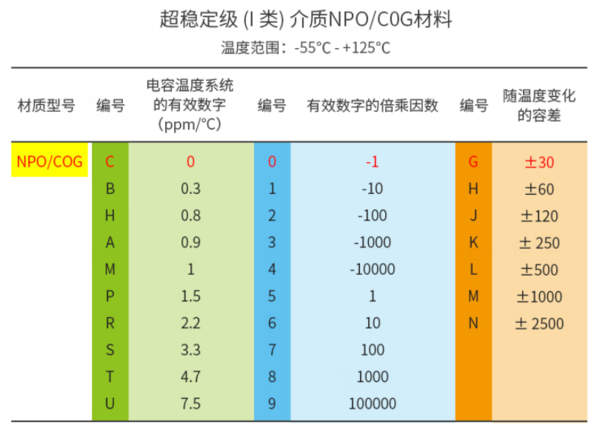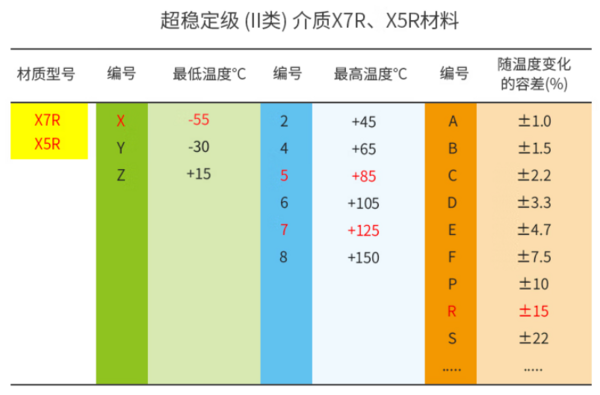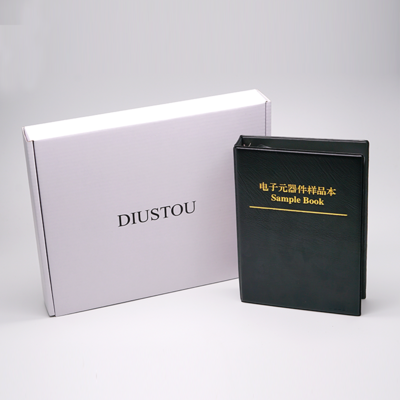SMD Capacitor Sample Book
From Diustou Wiki
| |||||||||||||||||||
| |||||||||||||||||||
| |||||||||||||||||||
| |||||||||||||||||||
Contents
Product Introduction
- This product is available in five sizes based on package dimensions: 0201, 0402, 0603, 0805, and 1206. Each model comes with a complete model label, and each type of capacitor includes 50 pieces, meeting daily demands. The sample book adopts a book-style design for easy reference, enhancing work efficiency.
Product Dimensions
Product Parameters
0201 Package
0402 Package
0603 Package
0805 Package
1206 Package
Material Description
- Different dielectric types have varying responses to electric field changes and polarization rates due to their primary polarization mechanisms. This results in different capacitances for the same volume, along with differences in dielectric loss and capacitance stability. Dielectric materials can be classified into two categories based on the temperature stability of their capacitance: Class I ceramic capacitors and Class II ceramic capacitors. NPO belongs to Class I ceramics, while X7R, X5R, Y5V, and Z5U belong to Class II ceramics.
Class I Ceramics
- Class I ceramic capacitors (Class I ceramic capacitor), formerly known as high-frequency ceramic capacitors, use non-ferroelectric (paraelectric) formulations with TiO2 as the main component (dielectric constant less than 150), providing the most stable performance. Alternatively, by adding small amounts of other (ferroelectric) oxides such as CaTiO3 or SrTiO3 to create "extended" temperature compensation ceramics, a nearly linear temperature coefficient can be achieved, with the dielectric constant increasing to 500. These two types have low dielectric loss, high insulation resistance, and good temperature characteristics. They are particularly suitable for oscillators, resonant circuits, coupling capacitors in high-frequency circuits, and other circuits requiring low loss and stable capacitance, or for temperature compensation.

- Temperature coefficient represented by C0G:
- C indicates that the effective digit of the capacitance temperature coefficient is 0ppm/℃
- 0 indicates that the multiplier factor of the effective digit is -1 (i.e., 10 to the power of 0)
- G indicates that the tolerance with temperature change is ±30ppm
- The final TCC of a C0G capacitor is: 0×(-1)ppm/℃ ±30ppm/℃
- Temperature coefficient represented by C0G:
- NPO is a term used in U.S. military standards (MIL), although it should technically be NP0 (zero). However, it is commonly written as NPO (Oh). It is an abbreviation for Negative-Positive-Zero, used to describe the temperature characteristic. It indicates that NPO capacitors have excellent temperature characteristics and do not exhibit capacitance drift with positive or negative temperature changes. C0G is the type with the best temperature stability in Class I ceramics, with a temperature characteristic close to zero, fulfilling the meaning of "negative-positive-zero". Therefore, C0G is essentially the same as NPO, just two different representations in different standards (of course, C0K, C0J, etc., with slightly smaller capacitance and slightly worse precision, are also NPO capacitors).
Class II Ceramics
- Class II ceramic capacitors (Class II ceramic capacitor), formerly known as low-frequency ceramic capacitors, refer to capacitors using ferroelectric ceramics as the dielectric, hence also known as ferroelectric ceramic capacitors. These capacitors have a high specific capacitance, with capacitance varying nonlinearly with temperature, higher loss, and are often used in electronic devices for bypassing, coupling, or in other circuits where loss and capacitance stability are not critical. Class II ceramic capacitors are further divided into stable and usable grades. X5R and X7R belong to the stable grade of Class II ceramics, while Y5V and Z5U belong to the usable grade. The main differences between X5R, X7R, Y5V, and Z5U lie in their temperature range and the variation of capacitance with temperature.

- Temperature range and capacitance variation with temperature represented by X7R:
- X indicates that the capacitor can operate at a minimum temperature of -55℃
- 7 indicates that the capacitor can operate at a maximum temperature of +125℃
- R indicates that the capacitance variation with temperature is ±15%
- The normal operating temperature range of X7R is -55℃ to +125℃, with a corresponding capacitance variation of ±15%
- Temperature range and capacitance variation with temperature represented by X5R:
- X indicates that the capacitor can operate at a minimum temperature of -55℃
- 5 indicates that the capacitor can operate at a maximum temperature of +85℃
- R indicates that the capacitance variation with temperature is ±15%
- The normal operating temperature range of X5R is -55℃ to +85℃, with a corresponding capacitance variation of ±15%
- Temperature range and capacitance variation with temperature represented by X7R:
FAQ
|






